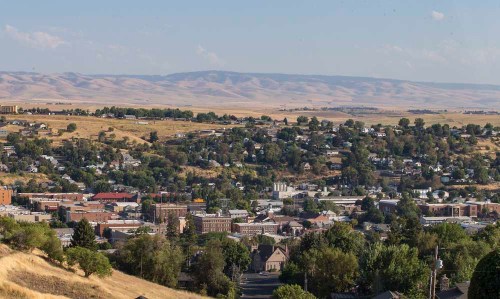Pendleton urban renewal could spend nearly $11M on streets
Published 6:00 am Tuesday, September 15, 2020

- The downtown urban renewal district can be seen from the top of the North Hill in Pendleton in 2019.
PENDLETON — Advisors to the Pendleton Development Commission are presenting two different courses of action ahead of the urban renewal district’s expiration date in 2023 — either try to rush against the clock to start as many projects as possible within the next few years, or do away with the clock entirely to keep going past 2023.
Fresh off his second stint on the Pendleton City Council, Chuck Wood stayed on as a member of the development commission’s advisory committee, which presented its plan for the urban renewal district’s future at a Tuesday, Sept. 8, meeting. In addition to creating new timelines, the advisory committee’s plan — “Keep Pendleton Buckin’” — could direct a windfall of money to the city’s beleaguered street system.
Established in 2003, Pendleton’s urban renewal district was started to improve downtown Pendleton and some of the surrounding area.
The city government “froze” the district’s property tax base, making money off increases to property value. The city created the development commission to oversee the district, gave it a 20-year lifespan and set a $36.4 million spending limit.
But as time winds down on the urban renewal district, the committee’s report states that the state no longer considers a time limit necessary.
And there’s still plenty of room for more spending, with the commission having spent only $6.8 million through the end of March.
In a Monday, Sept. 14, interview, Wood said it took time for money to start trickling into the urban renewal district, which didn’t generate revenue until 2005. It generated $44,545 that year but steadily grew year after year, with 2019 bringing in $873,878.
While the original plan called for more than two-thirds of the money to be funneled toward public projects, the commission has spent more than 40% of its funds on private projects like facade restorations, small business loans and second story developments.
Wood said it was a good move for the commission to initially focus on private projects because the resulting increase in property tax value helped generate more revenue for urban renewal. But with revenue now consistent, the commission could focus on improving public infrastructure.
Among other public improvements, the plan calls for $10.9 million for street and road reconstruction, but only within the boundaries of the urban renewal district.
“There are approximately 33,000 lineal feet of streets in poor or very poor condition in the Urban Renewal District,” the plan states. “Simple street repair, such as an overlay, cannot be funded through urban renewal. However, reconstruction, which requires removing all pavement down to the gravel underlay, then rebuilding both the pavement and adjacent curbs and perhaps the sidewalks, is allowed under urban renewal.”
The urban renewal funding would provide a big boost to the street system, which has had trouble gaining support in recent elections, which have seen voters twice reject a gas tax for street maintenance.
The revamped urban renewal district wouldn’t ignore private projects. The advisory committee’s proposal recommends $3.2 million for upper story developments, $1.3 million for the facade program and $1.5 million for grants to help businesses build new structures.
If the city council removes the urban renewal district’s self-imposed time limit, Wood doesn’t anticipate it will keep going until it hits its spending limit.
“I don’t think it will go that far,” Wood said, before adding that he envisions the commission discussing the future of the district every five years before deciding to keep going or pack it up.








